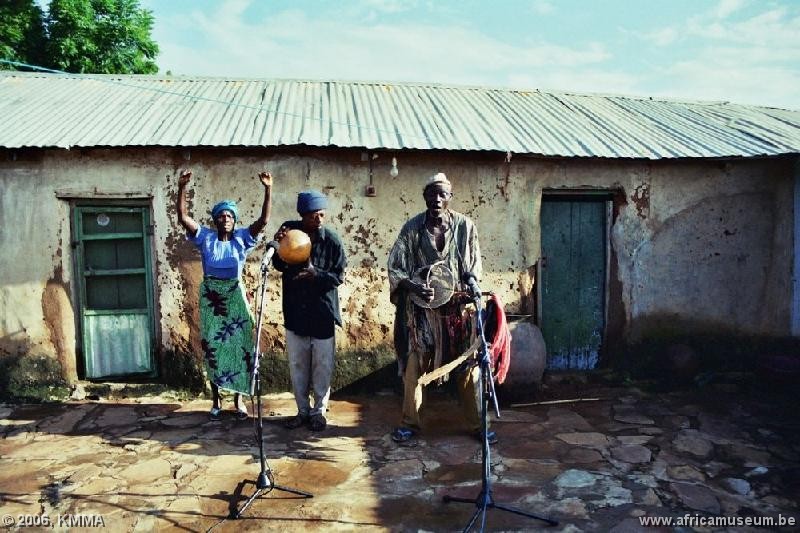Back
Traditional music of the Frafra
The Frafra live in north-eastern Ghana in the Upper East region in and
around the Bolgatanga District, where there is a population of around
40,000. They belong to the larger group of the Gurunsi (population 820,000:
2003 census), who live in southern Burkina Faso and in north-eastern Ghana.
Linguistically the Frafra belong to the Gur-Voltaic linguistic group. They
have several dialects, such as Gurune, Nankani, Talensi, Booni and Nabt. In
the literature the Frafra are also known as Gurune, Grunsi, Farefare,
Gurenne and Nankani. Their neighbours are the Kassena to the north-west,
the Mamprusi to the south, the Kusasi to the east and the Buli to the west.
The Frafra have a patrilineal structure. They do not have a king or chief,
but are ruled by elders.
The Frafra are mainly sedentary farmers who grow millet, sorghum and
yams, supplemented with maize, peanuts, rice and beans. On family land in
and around the village, the women plant tobacco and sesame seed and all
kinds of small crops that they can sell easily at the local market. During
the dry season the men go out hunting, which offers them a unique
opportunity to come into contact with the spirits of the primeval
forest.
The best-known artistic products of the Frafra are brass jewellery and
the decorative wall coverings in their houses. The Frafra musical culture
that we describe here is that of the village of Gambaga.
 The Frafra are known for their uninhibited artistic creations. Their
music is therefore characterized by a level of artistic skilfulness that is
encountered only among this people. During music
is a unique music genre that surpasses the gonje music of the
Dagomba and the Mamprusi in terms of virtuosity and phrasing. It also calls
for great musicality and imagination on the part of the musicians. The
during musician belongs to a caste of griots who perform a repertoire
that is both historic and topical. He is usually accompanied by a
siyarik gourd rattle. The lyrics are sung in a
responsorial style, with the during player singing the call line and the
siyarik player responding.
The Frafra are known for their uninhibited artistic creations. Their
music is therefore characterized by a level of artistic skilfulness that is
encountered only among this people. During music
is a unique music genre that surpasses the gonje music of the
Dagomba and the Mamprusi in terms of virtuosity and phrasing. It also calls
for great musicality and imagination on the part of the musicians. The
during musician belongs to a caste of griots who perform a repertoire
that is both historic and topical. He is usually accompanied by a
siyarik gourd rattle. The lyrics are sung in a
responsorial style, with the during player singing the call line and the
siyarik player responding.
 The Frafra people know the kon, a two-string
lute that is related to the biegu of the Dagomba, the kono
of the Kassena and the konde of the Bisa. The instrument is played
in public pito bars for entertainment purposes (a pito bar is
a public drinking establishment where pito (millet beer) is served,
a local alcoholic beverage of the Frafra).
The Frafra people know the kon, a two-string
lute that is related to the biegu of the Dagomba, the kono
of the Kassena and the konde of the Bisa. The instrument is played
in public pito bars for entertainment purposes (a pito bar is
a public drinking establishment where pito (millet beer) is served,
a local alcoholic beverage of the Frafra).
Slaves from Senegal are thought to have taken this instrument to the
Caribbean islands in the 17th century, where it was called the banjar. When
it later arrived in North America, a fifth string was added and a metal
soundbox replaced the gourd. This rudimentary musical instrument is
probably the predecessor of the modern banjo, which is familiar to us in
North American country and blues music.
The Frafra also have a whole range of drums, such as the
lung doo, the
lung nianga and the
gungon nu, which are played to accompany
dancing and singing.
The Frafra also have a large repertoire of women's songs that they
call paga yila. The leader sings the call
line and the chorus sings the response. The songs may be either homophonic
or heterophonic in texture.
Finally, the Frafra perform various dances, including the
nagila, a dance with a driving rhythm.
© RMCA/Dominik PHYFFEROEN
 The Frafra are known for their uninhibited artistic creations. Their
music is therefore characterized by a level of artistic skilfulness that is
encountered only among this people. During music
is a unique music genre that surpasses the gonje music of the
Dagomba and the Mamprusi in terms of virtuosity and phrasing. It also calls
for great musicality and imagination on the part of the musicians. The
during musician belongs to a caste of griots who perform a repertoire
that is both historic and topical. He is usually accompanied by a
siyarik gourd rattle. The lyrics are sung in a
responsorial style, with the during player singing the call line and the
siyarik player responding.
The Frafra are known for their uninhibited artistic creations. Their
music is therefore characterized by a level of artistic skilfulness that is
encountered only among this people. During music
is a unique music genre that surpasses the gonje music of the
Dagomba and the Mamprusi in terms of virtuosity and phrasing. It also calls
for great musicality and imagination on the part of the musicians. The
during musician belongs to a caste of griots who perform a repertoire
that is both historic and topical. He is usually accompanied by a
siyarik gourd rattle. The lyrics are sung in a
responsorial style, with the during player singing the call line and the
siyarik player responding.